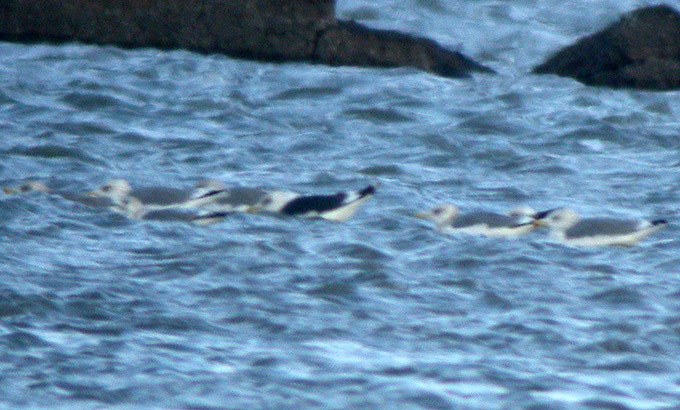
Close inpsection of the image is needed to see that the head is rather small (though appearing larger in this image due to the white background) , and largely unstreaked, with only a dark eye-patch.
A survey of shorebirds and gulls along the west coast has included the discovery of South Korea’s first Lesser Black-backed Gull Larus fuscus on Yubu Island in the Geum Estuary, on December 31, 2008. It was found by Nial Moores and seen by Soenke Tautz, Jörg Langenberg, Heiko Kratezel, Kirsten Kraetzel, Thomas Langenberg and Johanna Rathberger-Khan – the latter observers all experienced with nominate fuscus and heuglini, as well as with western forms of Lesser Black-backed Gull, known to NM from western Europe.
Even with extremely long range scope views (perhaps from over 2km away!) the bird’s blackish ‘sadddle’ was striking. Seen rather closer, down to c. 250 m through 60x optics, as seen in the images the dark of the upperparts was several shades of grey darker than the accompanying taimyrensis, vegae and mongolicus gulls, and obviously darker than several adult Slaty-backed Gull L. schistisagus and Black-tailed Gull Larus crassirostris, all seen in direct comparison. The head appeared largely white, with streaking confined more or less to a dark patch near the eye; the bill was apparently unmarked with black, was paler towards the base and was not as bright as in taimyrensis; and the primaries appeared “stubby”, and in active moult. Although structure can vary according to conditions, the bird appeared lightly-built, “Lesser Black-backed –like”, and smaller than many of the large gulls around it.

Note that the grey of the "saddle" in taimyrensis is similar to that of L. fuscus graellsii. Even in this image, the comparitive darkness of the saddle is striking, while the bird's plain bill, almost white head and "stunted" look due to incomplete primary moult area also visible.
It was seen well in flight only once (NM only), when it also appeared slender and smaller than vegae in direct comparison. Most striking was the lack of obvious contrast between the upperside of the primaries and the rest of the dark of the upperparts: only when it banked fully, tipping towards the sun, could contrast be seen. It also lacked both the “string of pearls” primary pattern shown by Slaty-backed Gull, and the typically obvious mirrors of taimyrensis, showing only a small mirror on P10 and apparently no mirror, or only a very tiny one, on P9.
Identification as Lesser Black-backed Gull was based on a combination of its blackish saddle (believed out of the range of any regularly occurring gull in the region, and blacker than any gull seen by NM in 18 years in East Asia); its small size and structure; and its apparently unmarked bill. Subspecific identification (i.e. of nominate fuscus and intermedius) cannot be made with any confidence, though the darkness of its upperparts, the state of moult and probability (based on range and its documented occurrence of a bird banded in Finland in 1957 found dead on Cocos Island, Australia, in 1959) suggest that nominate fuscus, popularly known as Baltic Gull, might be the most likely to occur in Korea.




